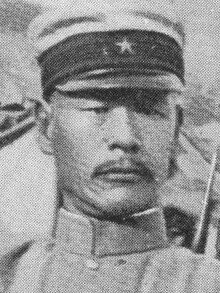Ichinohe Hyoe
Ichinohe Hyōe ( Japanese 一 戸 兵衛 ; born August 2, 1855 in Iwate Prefecture , Japan ; † September 2, 1931 in Tokyo ) was a general in the Imperial Japanese Army . He was known for the fact that troops under his command suffered very little losses by comparison thanks to sophisticated planning.
Life
Ichinohe was born in Tsugaru , the eldest son of a samurai family . In 1876 he enrolled in the emerging Imperial Japanese Army and was assigned to the 2nd Infantry Regiment as a sub-lieutenant. He fought with honors on the side of the Imperialists during the Satsuma Rebellion and was promoted to lieutenant in May 1877 after being wounded. In February 1878 he moved to the 1st Infantry Regiment.
Ichinohe received his first command during the Sino-Japanese War when he led the Oshima Mixed Brigade at the Battle of Seonghwan on July 29, 1894. Later he was in command of the 5th Division in the battle of Pyongyang on September 15, 1894 , with the rank of lieutenant colonel .
In 1897, after being promoted to colonel, he was given command of the 4th Regiment of the Imperial Japanese Guard . The following year he became Chief of Staff of the 6th Division .
After promotion to major general in May 1901, Ichinohe became the division's commander. In the Russo-Japanese War he served in the staff of the 3rd Army and took part in the Battle of Mukden . After the war he received the prestigious command of the 1st Division and was promoted to lieutenant general in November 1907 . After that he was first commander of the 17th division . In September 1911 he moved to the 4th Division before returning to the 1st Division in January 1912.
In February 1915 Ichinohe was appointed to the Supreme War Council and in August of the same year he was promoted to full general. From December 1915 on, he was one of three Inspector General of Military Education and held that post until he retired in June 1920.
A month earlier, in May 1920, he had accepted the post of director of the Gakushūin aristocratic school. From August 1924 he was a Shinto priest in the Meiji Shrine and from February 1926 until his death he was President of the Japanese Veterans Association. His grave is in the Tama Cemetery in Tokyo.
literature
- Richard Connaughton: The War of the Rising Sun and the Trumbling Bear - A Military History of the Russo-Japanese War 1904-5. Cassell, London 1988, ISBN 0-415-00906-5 .
- Trevor N. Dupuy : Encyclopedia of Military Biography. IB Tauris & Co. Ltd., 1992, ISBN 1-85043-569-3 .
- Stewart Lone: Japan's First Modern War: Army and Society in the Conflict with China, 1894–1895. MacMillan Press, 1994, ISBN 0-333-55554-6 .
| personal data | |
|---|---|
| SURNAME | Ichinohe, Hyoe |
| ALTERNATIVE NAMES | 一 戸 兵衛 (Japanese) |
| BRIEF DESCRIPTION | General of the Imperial Japanese Army |
| DATE OF BIRTH | August 2, 1855 |
| PLACE OF BIRTH | Iwate Prefecture , Japanese Empire |
| DATE OF DEATH | September 2, 1931 |
| Place of death | Tokyo |
